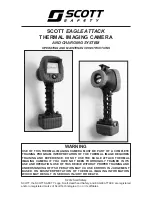
P/N 595224-01 Rev E 7/12
Page 9 of 32
BATTERY SAFETY WITH THE LI-ION BATTERY PACK
HANDLING
•
Use care when handling the lithium-ion battery pack used with the
EAGLE ATTACK
Thermal Imaging Camera.
•
Always inspect batteries before use. The electrolyte contained within the lithium-ion
cells can cause severe irritation to the respiratory tract, eyes and skin. A ruptured
battery cell can vent hazardous air contaminants, including corrosive or flammable
vapors. All precautions should be taken to limit exposure to the electrolyte vapor.
If the battery has a damaged or broken battery housing, remove the battery from
service and tag for proper disposal and replacement.
•
Never try to open or service a battery pack. There are no user serviceable parts
in the battery pack.
•
Dispose of depleted or damaged batteries in accordance with federal, state, and
local environmental regulations.
•
If the contacts of the battery are ever shorted by contact with something metal, an
internal circuit breaker will open making the battery inoperative. Simply place the
battery in the charger and charge to reset the circuit breaker and return the battery
to service.
CAUTION
IF THE CONTACTS OF THE BATTERY ARE EVER SHORTED BY CONTACT WITH
SOMETHING METAL, AN INTERNAL CIRCUIT BREAKER WILL OPEN MAKING THE
BATTERY INOPERATIVE. SIMPLY PLACE THE BATTERY IN THE CHARGER AND
CHARGE TO RESET THE CIRCUIT BREAKER AND RETURN THE BATTERY TO
SERVICE.
SHIPPING
•
Shipping restrictions may apply to the lithium-ion batteries used with the
EAGLE
ATTACK
Thermal Imaging Camera. For DOT purposes, the battery pack used is
considered a Small size secondary (rechargeable) battery.
•
Follow the appropriate regulations for shipment. Package batteries securely. Weight
limits apply to batteries and to batteries with equipment for passenger and/or cargo
aircraft. Pursuant to 49 CFR 173.185, all shipments of hazardous materials must
comply with packaging regulations based on the recommendations made by the
United Nations. There can be substantial fines and penalties for non-compliance.
CHARGING
•
Before using the
EAGLE ATTACK
Thermal Imaging Camera, charge the battery
according to the USE OF THE CHARGING SYSTEM section of this instruction. A
battery may be charged either attached to the camera, or in the extra battery bay
on the charger.
•
Leaving a battery in the charger after it is fully charged will not harm the battery.
•
Although the camera is intended to operate in potentially severe environments, avoid
storing or charging the battery in extremes of temperature, hot or cold. Charge and/
or store the battery pack in a dry location at normal room temperature (no more than
77°F/ 25°C). It takes a longer time to charge the battery in cold temperatures. And
storing or charging the battery in high temperatures can degrade the battery.
•
Through repeated use and recharging, a battery will eventually break down and
may not provide the duration of service it did when it was new.


























